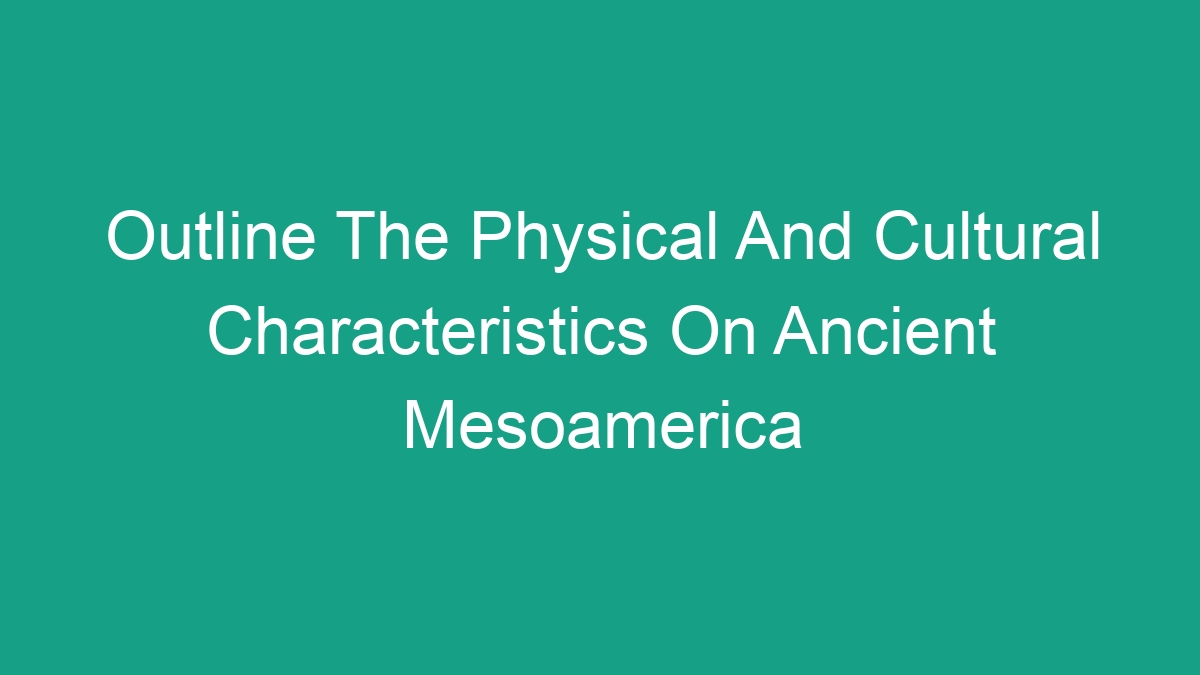
Introduction
Ancient Mesoamerica, a region located in present-day Mexico and Central America, was home to several influential civilizations, such as the Olmec, Maya, Aztec, and Zapotec. These civilizations left an indelible mark on history, and their physical and cultural characteristics continue to fascinate and intrigue scholars and enthusiasts alike. In this article, we will outline the physical and cultural characteristics of ancient Mesoamerica, shedding light on the unique attributes that defined this vibrant and diverse region.
Physical Characteristics
Location and Geography: Ancient Mesoamerica was geographically diverse, encompassing a wide range of landscapes, including tropical rainforests, highland plateaus, coastal plains, and mountainous regions. This diversity played a crucial role in shaping the civilizations that thrived in this area, influencing their agricultural practices, trade networks, and social structures.
Climate: The climate in ancient Mesoamerica varied from region to region, but generally speaking, it was characterized by a wet and dry season. This seasonal pattern influenced agricultural cycles and the availability of natural resources, shaping the livelihoods of the ancient Mesoamerican people.
Natural Resources: The region was rich in natural resources, including abundant crops such as maize, beans, and squash, as well as precious materials like jade, obsidian, and precious metals. These resources were essential for the development of complex societies and the flourishing of trade networks.
Environmental Challenges: Despite the abundance of natural resources, ancient Mesoamerica was also prone to environmental challenges, such as hurricanes, volcanic eruptions, and earthquakes. These natural disasters impacted the livelihoods of the people and often played a role in shaping their religious beliefs and rituals.
Cultural Characteristics
Religion and Mythology: Ancient Mesoamerican civilizations were deeply religious, with complex belief systems and mythologies that permeated every aspect of their lives. For example, the Maya believed in a pantheon of gods and goddesses, while the Aztec worshipped deities such as Quetzalcoatl and Huitzilopochtli. These religious beliefs were reflected in art, architecture, and daily rituals, and played a central role in shaping the cultural identity of these civilizations.
Art and Architecture: The ancient Mesoamerican civilizations were renowned for their exquisite art and architecture, which often showcased intricate designs, vibrant colors, and symbolic motifs. Temples, palaces, and ball courts were constructed with precision and adorned with elaborate carvings and sculptures, reflecting the cultural and religious significance of these structures.
Writing and Hieroglyphs: The Maya, in particular, developed a sophisticated writing system using hieroglyphs, which allowed them to record historical events, religious ceremonies, and astronomical knowledge. This written language was a crucial aspect of their cultural identity and played a pivotal role in the transmission of knowledge and tradition.
Social Structure and Governance: Ancient Mesoamerican societies were characterized by complex social hierarchies, with rulers, priests, and warriors occupying privileged positions in society. The governance of these civilizations varied, with some societies being governed by divine kingship, while others had elaborate systems of bureaucracy and law.
Legacy and Influence
The physical and cultural characteristics of ancient Mesoamerica have had a lasting impact on the world. The agricultural practices and crops developed in this region, such as maize and avocado, continue to be central to global food systems. The architectural and artistic achievements of the ancient Mesoamerican civilizations have inspired artists and architects around the world, while their religious beliefs and mythologies continue to captivate the imagination of modern audiences.
The legacy of ancient Mesoamerica is also evident in the linguistic and genetic diversity of present-day Mexico and Central America, as well as in the numerous archaeological sites and artifacts that bear witness to the achievements of these remarkable civilizations. The study of ancient Mesoamerica continues to be a rich and rewarding field of research, shedding light on the complex and vibrant cultures that flourished in this region.
In conclusion, the physical and cultural characteristics of ancient Mesoamerica are a testament to the ingenuity, creativity, and resilience of the indigenous peoples who inhabited this region. Their achievements continue to inspire and awe, serving as a reminder of the rich cultural heritage that has shaped the world we live in today.



